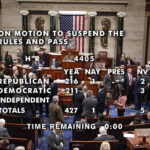Trump’s BLS Pick Proposes Suspending Monthly Jobs Report Releases/ Newslooks/ WASHINGTON/ J. Mansour/ Morning Edition/ President Donald Trump’s nominee for Bureau of Labor Statistics commissioner, economist EJ Antoni, says the agency should suspend its monthly jobs report until accuracy improves. Antoni proposes releasing only revised quarterly data, citing large recent revisions to employment figures. The comments follow Trump’s firing of former commissioner Erika McEntarfer over alleged flaws in the July jobs report.

BLS Commissioner Nomination Quick Looks
- Trump nominates EJ Antoni as new Bureau of Labor Statistics commissioner.
- Antoni calls monthly jobs report “unreliable” and favors quarterly releases.
- Suggests changes to methodology before resuming monthly data publication.
- Trump fired former commissioner after July report showed weak job growth.
- July report revisions for May and June cut totals by over 250,000 jobs combined.
- Antoni disagrees with Trump’s claim of intentional manipulation.
- Large revisions have become more common since the pandemic.
- BLS data is routinely revised as more complete information becomes available.
- BLS annual benchmark uses Quarterly Census of Employment and Wages for final counts.
- Proposal could impact Wall Street, policymakers, and public economic confidence.
Trump’s BLS Pick Proposes Suspending Monthly Jobs Report Releases
Deep Look
President Donald Trump’s pick to lead the Bureau of Labor Statistics (BLS) is raising eyebrows with a proposal to suspend one of the nation’s most closely watched economic indicators — the monthly jobs report. Economist EJ Antoni, nominated Monday, argues the monthly data has become unreliable and should be replaced with quarterly releases until methodological improvements are made.
In an interview with Fox Business published Tuesday, conducted prior to his nomination, Antoni said the BLS should temporarily halt the monthly reports and instead publish only quarterly numbers, which are revised and considered more accurate.
“Until it is corrected, the BLS should suspend issuing the monthly job reports but keep publishing the more accurate, though less timely, quarterly data,” Antoni told the outlet. He stressed that confidence in the data is vital because “major decision-makers from Wall Street to D.C. rely on these numbers.”
The Firing That Set the Stage
The nomination follows Trump’s dismissal of former BLS commissioner Erika McEntarfer after the July jobs report showed weaker-than-expected employment growth and included historically large revisions for May and June. Trump labeled the revisions a “scam” and claimed, without providing evidence, that they were part of a vendetta against his presidency.
Antoni, however, does not believe the data was manipulated intentionally. He has criticized the agency’s approach to data collection, noting that revisions to monthly figures have become significantly larger since the COVID-19 pandemic disrupted economic patterns. Still, he acknowledged that while the recent May and June revisions were large, they were not entirely unprecedented in historical context.
The Numbers Behind the Revisions
The May jobs total was revised from an initial estimate of 139,000 to just 19,000 — a downward change of 120,000. June’s figure dropped from 147,000 to only 14,000 jobs after revisions, a cut of 133,000. These adjustments, while dramatic, are part of a normal revision process that dates back decades.
From 1979 to 2003, the average monthly revision was around 61,000 jobs. After the BLS introduced a probability-based sample design in 2003, the average revision dropped slightly to 51,000. However, the pandemic’s seismic impact on supply chains, consumer behavior, and business operations has made collecting accurate, timely labor data more difficult.
Why Revisions Happen
The monthly jobs report is based on two large surveys — one of households and another of businesses — and often relies on incomplete data. As more complete information arrives in the following weeks, the BLS issues two subsequent revisions. In addition, the agency uses modeling to account for employment at newly opened and closed businesses, an approach that adds complexity and potential volatility.
Every year, the BLS also conducts an annual “benchmark revision,” replacing survey-based employment estimates with more comprehensive counts from the Quarterly Census of Employment and Wages (QCEW). This census uses quarterly unemployment insurance tax records submitted by employers, offering a fuller — though more delayed — picture of labor market activity.
Potential Impact of Suspending Monthly Reports
Suspending monthly jobs reports would represent a major shift in how labor data is disseminated in the United States. The report is a key market-moving indicator that influences Federal Reserve policy decisions, corporate hiring strategies, and investor sentiment. Releasing data quarterly could reduce volatility caused by initial estimates but would also slow policymakers’ ability to respond to economic changes.
Antoni’s proposal highlights ongoing debates about balancing timeliness and accuracy in economic reporting. While critics argue that scrapping monthly releases would deprive decision-makers of crucial information, supporters say that overstated or unreliable data can be just as damaging as delayed data.
For now, the BLS will continue its regular schedule unless Antoni is confirmed and implements his recommended changes. His nomination will likely draw scrutiny from both political opponents and economists concerned about the broader implications for transparency and market stability.







